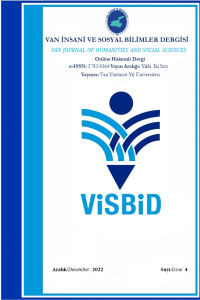Abstract
Türklerin Anadolu’ya girişinin en önemli noktası olan Ahlat, doğu-batı sentezinin kavşak noktası konumundadır. Tarihin ilk çağlarından günümüze kadar verimli toprakları, stratejik konumu ve sahip olduğu doğal kaynaklar gibi nedenlerden dolayı farklı uygarlıkların yerleşim alanı olmuştur. Stratejik konumu ve doğudan gelerek Van- Erciş- Adilcevaz-Ahlat-Bitlis güzergahında devam eden İpek yolu üzerinde bulunması nedeniyle çeşitli devletlerin hedefinde bulunmuş, özellikle Ortaçağda sık sık el değiştirmiştir. Bu topraklarda hâkimiyet kurmuş uygarlıklar kendi kültürlerini ve geleneklerini yansıtan eserler icra etmişlerdir. Her uygarlık inşa ettiği askeri yapılarla gücünü, ticari yapılarla güvenli ticareti, sivil yapılarla toplumsal refahı, mabetleriyle dinini yüceltmeyi, anıtsal mezar yapıları ve mezar taşlarıyla da ölülerine duyduğu derin saygıyı ve ahiret inancını göstermek istemiştir. Ahlat, sahip olduğu mezar taşları ile kültür tarihimiz açısından somut veriler sunan ve bu yönüyle Anadolu’daki varlığımızı belgeleyen önemli bir kültür varlığı potansiyeline sahiptir. Özellikle Ortaçağ dönemine ait kültür varlıkları önemli bir yer tutmaktadır. Bu kültür varlıklarının içerisinde de tarihi mezar taşları Ahlat özdeşleşmiştir. 210.000 m2 alanıyla Ahlat’taki tarihi mezarlıkların en büyüğü olan Selçuklu Meydan Mezarlığı, aynı zamanda Türkiye’nin de en büyük Türk-İslam tarihi mezarlığı unvanına sahiptir.
Meydan Mezarlığı’ndaki mezar taşlarının en önemli özelliklerinden biri yaklaşık 500 örnekte sanatkâr kitabesine yer verilmiş olmasıdır. Bu sanatkâr kitabeleri Anadolu’nun diğer mezar taşlarında nadir görülen bir uygulamadır. Yaklaşık 500 sanatkâr içerisinde yer alan Hasan Bin Yusuf adlı sanatkârın imzasını taşıyan mezar taşları, bu çalışmanın ana konusunu oluşturmaktadır. Bu eser malzeme, süsleme, tipoloji ve kitabe içerikleri yönleriyle incelenerek değerlendirilmiştir. Sanatçının Meydan Mezarlığı’nda iki eseri tespit edilmiştir. Çalışmaların devamında Ahlat Mezarlıklarında başka eserlerinin de bulunması ihtimal dahilindedir.
References
- Beygu, Ş. A. (1932). Ahlat Kitabeleri, İstanbul: Hamit Matbaası, 35. Çelebi, E. (1935). Seyahatname, c.(4), İstanbul: Devlet Matbaası, 139. Karahan, R., Güzel, E. (2013). Eski Ahlat Şehri Kazıları, 35. Kazı Sonuçları Toplantısı, Muğla: 339-347 Karahan, R., Kulaz, M., Güzel, E. (2014). Eski Ahlat Şehri Kazıları, Uluslararası 36. Kazı Sonuçları Toplantısı, 499-510
Abstract
Ahlat, the most important point of the Turks' entry into Anatolia, is the junction point of the east-west synthesis. Since the first ages of history, it has been the settlement area of different civilizations due to its fertile lands, strategic location and natural resources. Due to its strategic location and being on the Silk Road, which comes from the east and continues on the Van-Erciş-Adilcevaz-Ahlat-Bitlis route, it was the target of various states and changed hands frequently, especially in the Middle Ages. Civilizations that have established dominance in these lands have performed works that reflect their own cultures and traditions. Every civilization wanted to show its strength with the military structures it built, safe trade with commercial structures, social welfare with civil structures, glorifying its religion with its temples, and its deep respect for its dead and belief in the hereafter with its monumental tombs and tombstones. Ahlat, with its tombstones, has the potential of an important cultural asset that provides concrete data in terms of our cultural history and documents our presence in Anatolia in this respect. Especially the cultural assets of the Middle Ages have an important place. Among these cultural assets, historical tombstones are identified with Ahlat. Seljuk Meydan Cemetery, which is the largest of the historical cemeteries in Ahlat with an area of 210,000 m2, also has the title of the largest Turkish-Islamic historical cemetery in Turkey.
One of the most important features of the tombstones in Meydan Cemetery is the inscription of the craftsman in approximately 500 samples. These craftsman inscriptions are a rare practice in other tombstones of Anatolia. The tombstones bearing the signature of Hasan Bin Yusuf, who is among about 500 artisans, constitute the main subject of this study. This work has been evaluated in terms of material, ornamentation, typology and inscription contents. Two works of the artist have been identified in the Meydan Cemetery. It is possible that other works will be found in the Ahlat Cemeteries in the continuation of the studies.
References
- Beygu, Ş. A. (1932). Ahlat Kitabeleri, İstanbul: Hamit Matbaası, 35. Çelebi, E. (1935). Seyahatname, c.(4), İstanbul: Devlet Matbaası, 139. Karahan, R., Güzel, E. (2013). Eski Ahlat Şehri Kazıları, 35. Kazı Sonuçları Toplantısı, Muğla: 339-347 Karahan, R., Kulaz, M., Güzel, E. (2014). Eski Ahlat Şehri Kazıları, Uluslararası 36. Kazı Sonuçları Toplantısı, 499-510
Details
| Primary Language | Turkish |
|---|---|
| Journal Section | Research Articles |
| Authors | |
| Publication Date | December 29, 2022 |
| Submission Date | October 7, 2022 |
| Published in Issue | Year 2022 Issue: 4 |
ViSBiD, MLA ve Crossref tarafından indekslenmektedir. Ayrıca Index Copernicus takip sistemine alınmıştır.


